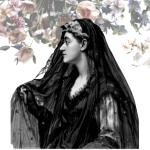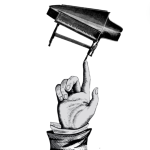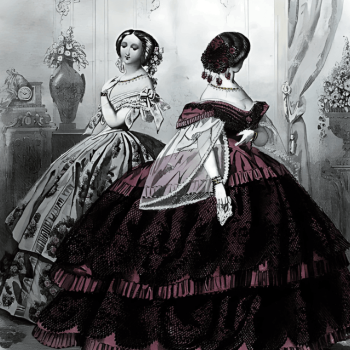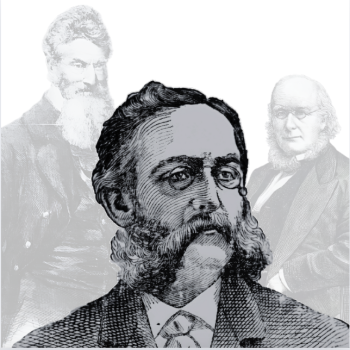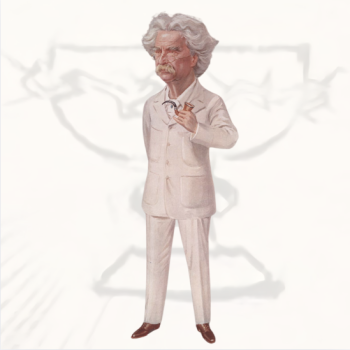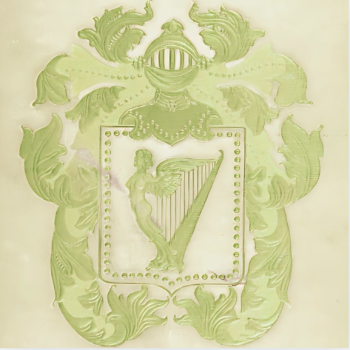When Olcott returned to New York, he was approached by William Quan Judge, a young lawyer whom he knew from City Hall. He was the proud father of a two-month-old child, whom he and his wife Ella named Alice, after Judge’s late-mother.[1] He had come to ask for an introduction to Madame Blavatsky. Olcott told him that he would see what he could do.
In the summer of 1874, while Olcott was conducting his first tests at the Eddy farm, Judge was representing Marietta Post, a patient in the Homeopathic Asylum for the Insane at Middletown. It was an appeal “adjudging the lunatic to be a county charge under the law.” This test case in determining if “indigent and pauper lunatics” could, if so desired, be sent nolens volens as a county charge to a homeopathic hospital.[2] A month later, on September 16, 1874, Judge married Ella.[3]
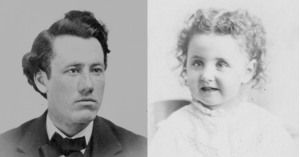
William Quan Judge & Alice Olive Judge.
Hardly an affluent family, the Judges lived with Ella’s widowed father, a shoe-dealer named Joseph Smith, at 160 Gold Street in the Vinegar Hill neighborhood of Brooklyn, known colloquially as “Irish Town.”[4] This was appropriate enough. Judge himself was born in Dublin, Ireland, on April 13, 1851, the third of six children born to Alice Mary (née Quan,) and Frederick Hughes Judge, a clothing merchant who worked on Dublin’s Wicklow Street.[5] He was named after his maternal grandfather, William Quan.[6] His parents were married in St. Thomas Parish, Church of Ireland, suggesting that in his early years at least, the Judge family belonged to that church.[7]
He grew up in the “Docklands,” a “very poor locality” on the fringes of Dublin.[8] Conditions in the North Dock Ward, though still a very poor locality, had seen some incremental improvements during Judge’s early childhood. The abandoned homes on Beaver Street were replaced with new ones. The ruins of the large dairy yard, and old vinegar works on Sheriff Street were demolished and four houses built on the site. The dilapidated structures on Church and Amien Streets, reclaimed by the swampy borders, had also been removed. It was said that the English landlord had planned on building several cottages on this site that had not long since been considered irreclaimable in the locality.[9]
Light-hearted, fun loving, and healthy, Judge busied with games and his studies. The most significant feature of this period was a very severe sickness which Judge contracted at the age of seven. This attack was so serious that he even stopped breathing for some time, and it was feared that he had died. In the midst of his family’s outburst of grief, Judge began to breathe once more. However, it was not an uncommon occurrence for a patient who survived a severe sickness to be changed in many ways. It was as though sickness and suffering had opened a previously unknown door in his heart. He became deeply studious, and devoured any book he could lay his hands on, and at an age when his family were not even aware that he had learned to read at all. He read with absorbed interest works on religion, philosophy, sacred legends and traditions, myths, and magic, mesmerism, phrenology, character-reading, Rosicrucianism, and the Book of Revelation (trying to discover its real meaning.)[10] He had an occult tendency in him, “hardly suspected as yet by himself, and not in the least visible outwardly.”[11] Though he was an avid reader, Judge was not, a “bookworm.” He also read books, magazines, newspapers, and people in his pursuit to unravel life’s mysteries—especially of human nature.[12]
The shock of his narrow escape from death at that early age, however, took a severe toll on his physical development (which never recovered as fully as he wished.) Though physically frail, he had a well-preserving and indomitable personality beyond any child his age. There was a story his family well-remembered during this time, when young Judge was playing with some other boys on the bank of a stream. His companions swam to an island a little way off from the bank and from this point began to jeer at Judge, who could not swim. Hot with remorse and indignation, Judge was determined to reach the island, or die in the attempt.[13] He plunged in, got out of his depth, and sank; he touched the bottom, pushed on a step or two on the river bed, rose, drew breath, and kicked. He sank, took a step, and repeated the process. Struggling, rising, catching breath, and holding it, sinking, and scrambling, he eventually reached the margin of the island, where he was drawn out of the water, half-unconscious, by his astonished playmates.
In 1860, Judge’s life changed. His mother died in childbirth in their family home at 36 Seville Place.[14] “I have seen ghosts ever since I was a boy,” Judge would later say, “my mother, being dead, appeared at my bedside and looked down on me.”[15]
At the age of thirteen, Judge and his surviving siblings immigrated to America with their father, arriving in New York on July 11, 1864.[16] On June 29, just before their ship, the Limerick, sailed, a resolution was moved in the British House of Commons, acknowledging, and regretting, the immigration from Ireland, and calling on the government “to devise a means to check it.” It was a strong condemnation of the practice with which the Americans resorted to “in order to induce immigrants to serve in the Federal Army.”[17] They arrived in an America that could hardly be called a United States. On the day the Limerick anchored in the North River, the headlines announced that the Confederate General, Jubal Early, had advanced the rebel army to within five miles of Washington, D.C.[18] It was unclear when the war, which had lasted three years already, was going to end. If it lasted another three, Judge, as all Irish families well-knew, would be forced to fight. It was this reason that, a year earlier, on June 11, 1863, the Draft Riot erupted, which saw racial tensions between the most impoverished New Yorkers, that is to say, the Irish and the Blacks, escalate into violence.[19]
For their first few months in America, the Judge family resided in a room at The Merchants’ Hotel, a large hostelry covering two lots, 39-41 Cortlandt Street, which connected on the side toward Broadway. The building, as its name suggests, was a favorite resort of the merchants of the American West and, before the war, the South. They flocked to New York in the thousands, making semi-annual trips to purchase goods from the great wholesale houses of lower Manhattan. Having opened its doors to guests in 1839, the 100, handsomely furnished rooms of the Merchant’s, were already considered to be of a “good old-fashioned kind,” by 1864, as newer, more palatial buildings were being built uptown. Nevertheless, the Merchant’s “held its own against the advances of style and the revolution in hotel-building,” for it was fondly associated with the growth and development of the city. It was, in a sense, legendary in its own time. Guests at the hotel (and the occasional transient en route from the Cortlandt Street Ferry,) were known to study the “chirography of their ancestors,” in the hotel register, a nuisance which the proprietors, William Schenck and Mr. Clark, obligingly indulged.[20]
Even the most spacious of rooms become claustrophobic when shared between a father, and six children; three boys, and three girls, siblings whose ages ranged between six and sixteen. Judge, an introverted, twelve-year-old boy, found little time for contemplation at home. This, no doubt, contributed to his life-long distaste for hotels.[21]
Within a year, the family would move to Brooklyn’s 9th Ward, the current day neighborhood of Park Slope.[22] Taking root in Brooklyn, Frederick raised the children “under the spiked yoke of hard Methodism.”[23] Fred Judge encouraged his children to be self-supporting at a young age, and Judge soon began work as a clerk in Manhattan. When he was nineteen, Judge became a law student, and was appointed a Notary Public for the City and County of New York.[24] By 1870 the family had moved to Brooklyn’s Tenth Ward (in what is now parts of Carroll Gardens and Boerum Hill.)[25] At this time Judge befriended Alfred Garraway, a young Englishman briefly employed at the New York World, but entered law at the same time as Judge when he realized he was ill-suited for a profession in journalism. The two men would meet daily, and had frequent conversations, but any discussions of a metaphysical nature were never approached. Whenever Judge tried to engage Garraway in such discussions, Garraway would declare that, like Henry Ward Beecher, “he accepted things as they are, and that if things were so and so, we could not alter them by our reasonings, and therefore ought not to bother ourselves in speculating about them.”[26] As another friend would write: “[Judge] had an aptitude for the law, and but one disqualification for it: he had spiritual aspirations intensely strong.”[27] It was a seemingly unlikely friendship. Having grown up in Ireland, Judge had an aversion to the English.[28] Nevertheless, their camaraderie flourished until tragedy struck on January 29, 1871, when the body of Alfred Garraway was found in his room. Having overdosed on a vial of sulphate of morphine, the circumstances of Garraway’s suicide became a topic of wide-speculation.[29] In June 1871, Judge would write to the Phrenological Journal, “in the cause of science, friendship, and truth to give a plain statement of facts,” in regards to the case, and dispel the sensational rumors then circulating.[30] Besides the inherent grief Judge must have felt with the loss of his friend, we might look to an essay Judge would later write to get a sense of his thoughts at this time. “Suicide like any other murder is a sin because it is a sudden disturbance of the harmony of the world.”[31]
Toward the end of 1871, the Y.M.C.U. held its nineteenth semi-annual meeting. The entertainment opened with a piano duet of Reissiger’s Die Felsenmühle performed by Regina Nachmann, and Judge’s sister, Alice, who was as a student Albert S. Caswell, and enjoying positive recognition as a “thoroughly good organist.”[32] After the pastor offered a short prayer, yearly reports were addressed, and testimonials declared, Judge read an essay titled “The Future.” It was said that Judge “was not an eloquent speaker, in the ordinary sense of the term; he used hardly any gestures; his style was simple, without a shadow of display; he said what he had to say, naturally and without effort; but he carried conviction,” but like his personality, the essay was both somber and humorous, and positively received.[33] “Mr. W.Q. Judge,” the Brooklyn Daily Eagle stated, “we should judge, has a future before him.”[34]
On April 15, 1872, Judge was living at 310 Schermerhorn Street in Brooklyn when he became a naturalized citizen of the United States. Judge began working as a clerk in the law office of George Pierce Andrews, a man who would prove an invaluable mentor. Andrews served as Assistant Attorney of the United States during the official terms of District Attorney, Edward Delafield Smith.[35] A mercantile lawyer, Smith was deeply interested in public affairs, and had a reputation for his strong ethics, and practical, approach to law. In April 1861, Smith accepted the appointment of President Abraham Lincoln to be the United States District Attorney for the Southern District of New York during a four-year term that coincided with the years of the Civil War. Smith successfully conducted many celebrated cases, such as procuring the conviction of John Andrews, one of the leaders of the Draft Riot of 1863. During the Civil War, Smith played a key role in prosecuting the military supplier, Soloman Kohnstamm, whose fraudulent dealings with the Federal Government resulted in the loss of half-a-million dollars. This case put Smith in close contact with Colonel Henry Steel Olcott, the Special Commissioner of the War Department, whose evidence in the trial enabled Smith to sentence Kohnstamm to Sing-Sing prison.[36] In April 1873, Smith, Counsel to the Corporation, would work with Olcott once again, as the latter was retained as Attorney for the City Treasury for “certain large suits.[37] Judge, who worked in the offices of both Andrews and Smith at City Hall, likewise worked with Olcott.[38]
In 1873 Judge was living at 27 Fourth Avenue, Brooklyn, and finding ways to balance his spiritual aspirations and his judicial vocation.[39] One such outlet was the new Young Men Christian Association, where he participated in mock trials.[40] Around this time Judge met Ella Miller Smith, likely through the church, as she was a devout Methodist; Ella’s parents, Emeline Smith (née Miller,) and Joseph Smith were for many years, both faithful members of the York Street Methodist Episcopal Church. By the time that Judge met Ella, however, her father, a Boston-native who worked as a shoe-dealer on Myrtle Avenue (Brooklyn,) was a widower twice over.[41] There are no records of their courtship, but it must have had some humorous moments; Judge being “an Irish emigrant boy; none too well-educated,” who “never could write English,” while Ella was a trained grammarian, with a strong command of the language.[42] A graduate from the Packer Collegiate Institute in 1871 (a school established in 1854 “for the Education of Females in the City of Brooklyn,”) Ella, in 1873, was teaching Fourth Grade Grammar at Brooklyn’s Grammar School No. 10. (Seventh Ave. and 17th Street.)[43]
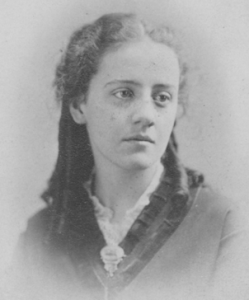
Ella Judge.
Outside of his network in the church, Judge ran with a circle of friends that included colleagues from City Hall, and reporters from New York’s leading newspapers. Of the young lawyers who Judge counted among his friends, we know of Johnny Logan, William Richards Castle, and William Learn. Castle, a lawyer just two years older than Judge, was born in the Kingdom of Hawaii and came to America to study at Harvard Law School, and later Columbia University. In 1874 Castle began his law career in New York and formed all his plans for a lifelong stay in that city.[44] Judge would accompany Logan to the poker-night of journalists at their club-meetings in Moretti’s restaurant. There Judge was introduced to reporters such as David A. Curtis, Edward Page Mitchell, and Frank Church.[45] Mitchell, editor, and correspondent for The Sun (New York,) described Judge as “a smooth spoken-person with contemplative eyes in which lurked both professional sagacity and somewhat of Oriental craftiness.”[46]
SOURCES:
[1] New York City Department of Records & Information Services; New York City, New York; New York City Birth Certificates; Borough: Brooklyn; Year: 1875.
[2] “A Highly Important Decision.” The Brooklyn Daily Eagle. (Brooklyn, New York) August 17, 1874.
[3] “New York, New York City Marriage Records, 1829-1940,” database, FamilySearch (https://familysearch.org/ark:/61903/1:1:24Z2-S6Z : 10 February 2018), William Q. Judge and Ella Miller Smith, 16 Sep 1874; citing Marriage, Brooklyn, Kings, New York, United States, New York City Municipal Archives, New York; FHL microfilm 1,543,913; Eek, Sven (ed.) Damodar And The Pioneers Of The Theosophical Movement. Theosophical Publishing House. Wheaton, Illinois. (1965) 76.
[4] New York State Census, 1875. Brooklyn, Kings, New York, United States. P. 13. Line 37. State Library, Albany; FHL microfilm 1,930,217; Stiles, Henry Reed. The Civil, Political, Professional and Ecclesiastical History, And Commercial and Industrial Record of The County of Kings and The City of Brooklyn, N. Y. From 1683 To 1884: Volume I. W.W. Munsell & Co. Brooklyn, New York. (1884): 104; “Joseph Smith.” The Brooklyn Daily Eagle. (Brooklyn, New York.) December 18, 1900; “Joseph Smith.” The Times-Union. (Brooklyn, New York.) December 18, 1900; Gardner, Juliet; Wenborn, Neil (eds.) The History Today Companion to British History. Collins & Brown. London, England. (1995): 782.
[5] “Novelties” Dublin Evening Packet and Correspondent (Dublin, Ireland), April 29, 1861.
[6] “Ireland Marriages, 1619-1898,” database, FamilySearch (https://familysearch.org/ark:/61903/1:1:FGFM-J5Z : 6 February 2020), William Quan in entry for Fredrick Hughes Judge, 1847.
[7] (Wedding): [“Ireland Civil Registration, 1845-1913,” database, FamilySearch (https://familysearch.org/ark:/61903/1:1:QL34-XPGF : 16 March 2021), Frederick Hughes Judge and Alice Quan, Marriage 02 Mar 1847, St. Thomas, Dublin North, County Dublin, Ireland; citing General Register Office, Dublin; FHL microfilm 101,286.] (In an advertisement for Frederick H. Judge’s clothing store he makes an appeal to the clergy of the Irish Church: “To the clergy of the Established Church. Being honored with the patronage of the most distinguished Clergymen in the city, I respectfully solicit, during the approaching April meetings, your inspection of my stock of superfine jet-black Saxony cloth of doeskins, suitable for clerical attire.”[Judge, Fred. H. “April Meetings.” The Dublin Evening Packet and Correspondent. (Dublin, Ireland) April 12, 1861.]
[8] Thomas. Thom’s Almanac and Official Directory of the United Kingdom of Great Britain and Ireland for the Year. Vol. XXVI. (1859): 1321.
[9] “Improvement Of The City.” The Dublin Builder. Vol. II No. 17 (May 1, 1860): 249.
[10] Niemand, Jasper. Letters That Have Helped Me. Vol. II The United Lodge Of Theosophists. Los Angeles, California. (1920): 105-106.
[11] Olcott, H. S. “Old Diary Leaves: Chapter VIII. ” The Theosophist. Vol. XIV, No. 3 (November, 1892): 67-75.
[12] Hargrove, Ernest Temple. “Letters From W.Q. Judge.” The Theosophical Quarterly. Vol. XXIX, No. 1. (July 1931): 35-44.
[13] M.M. “William Quan Judge: The Constant Warrior.” Raja-Yoga Messenger. Vol. XVII, No. 2 (March, 1921): 54-61.
[14] “Deaths.” The Dublin Evening Packet and Correspondent. (Dublin, Ireland) March 3, 1860.
[15] “Touched By Ghosts.” The Boston Globe. (Boston, Massachusetts) October 15, 1894.
[16] Year: 1864; Arrival: New York, New York, USA; Microfilm Serial: M237, 1820-1897; Line: 1; List Number: 661. In Letters That Have Helped Me, Julia Keightley states that the date of arrival was July 14, 1864. The closest to that date on which the Limerick was docked in New York, was July 11, 1864. While the manifest does not indicate a family with the surname Judge, it does show an Irish family named the Hughes (Frederick Judge’s middle name,) composed of a single father and his six children. Their names and ages on the manifest are nearly identical to the Judge family, (Frederick Hughes [40,] Lucy [16,] Alice [14,] William [12,] Emily [9,] John [7,] and Fritz [6,]) which suggests July 11, 1864, as the likely date of arrival. Keightley, Julia. Letters That Have Helped Me. Vol. II. The United Lodge of Theosophists. Los Angeles, California. (1920): 105-106.
[17] “Irish Emigration To America.” The New York Herald. (New York, New York) July 6, 1864.
[18] “The Situation.” The New York Herald. (New York, New York) July 11, 1864.
[19] The complex ecosystem of political (global and domestic,) economic, and racial tensions in America during this period can hardly be summarized with a few remarks. It is, perhaps, necessary, to touch upon, as this atmosphere would, to some extent, inform the worldview of the young Judge. On June 11, 1863, in New York City when more than 100 people were murdered by an angry mob. After burning down a draft office and attacking police officers and well-dressed whites, this mob of white workers, including many Irish Americans, focused its energy on killing African American bystanders. Irish immigrants shared with Blacks a position at the bottom of the economic tier in American society, and in areas with large Irish and Black populations, the two groups were often pushed into conflict. During and after the Civil War, Irish mobs participated in anti-black excesses as in the case of the Draft Riots in New York in 1863.[19] The Conscription Act of 1863 exacerbated tense relationships. This act made all white men between the ages of twenty and forty-five years eligible for the draft by the Union Army. Free African American men were permitted to “volunteer” to fight in the Civil War through the provisions of the Emancipation Proclamation. However, African American men were not drafted or otherwise forced to fight. In addition, white men with money could illegally bribe doctors for medical exemptions, legally hire a substitute, or pay for a commutation of a draft. The less affluent could not afford to pay for deferments. The inequities in draft eligibility between African Americans, monied whites, and working-class whites, of whom many were Irish, increased racial tensions. Several cities suffered draft riots in which enrollment officers and free African Americans were targeted for violence. The largest such incident began et there is a paradox in the Irish participation—in the North, the section most resistant to the war effort of Lincoln’s Republican government was the Irish-American community. The Irish were easily stirred into resisting radical measures like conscription and the emancipation of slaves. Economic rivalry with black Americans, and an acute psychological need to distinguish themselves from Blacks, made many disenfranchised Irish virulently racist. The worst expression of this was the New York draft riots of 1863 when blacks were murdered in the streets, homes of Irish army officers were attacked, and a black orphanage burned to the ground. [Joyce, Toby. “The American Civil War & Irish Nationalism.” History Ireland Vol. IV, No. 2 (Summer, 1996): 36–41; Finzsch, Norbert, and Dietmar Schirmer. “Police, African Americans, And Irish Immigrants In The Nation’s Capital A History Of Everyday Racism In Civil War Washington.” Essay. In Identity And Intolerance: Nationalism, Racism, And Xenophobia In Germany And The United States. German Historical Institute. Washington, D.C. (2002.): 175-208.]
[20] Niemand, Jasper. Letters That Have Helped Me. Vol. II The United Lodge Of Theosophists. Los Angeles, California. (1920): 105-106; “The Old Merchants’ Sold.” The Evening World. (New York, New York) October 10, 1887; Edwards, Richard. New York’s Great Industries: Exchange And Commercial Review, Embracing Also Historical And Descriptive Sketch Of The City, Its Leading Merchants and Manufacturers. Historical Publishing Company. New York, New York. (1884): 209; Disturnell, J. The Traveler’s Guide To The Hudson River. The American News Company. New York, New York. (1864): 11.
[21] Hargrove, Ernest Temple. “Letters From W.Q. Judge.” The Theosophical Quarterly. Vol. XXXII, No. 3. (January, 1935): 198-205.
[22] Phelps, Humphrey, Active 19Th Century, and H. P Cooper. Map of the city of Brooklyn. [New York New York: Henry Poolly Cooper lith, 1865] Map. https://www.loc.gov/item/2015585148/.; “New York State Census, 1865,” database with images, FamilySearch (https://familysearch.org/ark:/61903/1:1:QVNJ-Y7T2 : 8 March 2021), William Judge in household of Frederick Judge, Ward 09, Brooklyn, Kings, New York, United States; citing Census, p. 102.
[23] Olcott, H. S. “Old Diary Leaves: Chapter VIII.” The Theosophist. Vol. XIV, No. 3 (November 1892): 67-75.
[24] The Albany Law Journal: A Weekly Record Of The Law And Lawyers. Vol. I (January-July 1870.) Weed, Parsons & Co. Albany, New York. (1870): 342.
[25] “United States Census, 1870,” database with images, FamilySearch (https://www.familysearch.org/ark:/61903/1:1:M8NX-7GS : 29 May 2021), William Judge in entry for Frederick Judge, 1870.
[26] Judge, William Q. “The Boy Suicides Again.” The Phrenological Journal. Vol. LII, No. 6. (June 1871): 379-380.
[27] Langford. “A Reminiscence.” The Word. (November 1915): 75-89.
[28] Hargrove, Ernest Temple. “Letters From W.Q. Judge.” The Theosophical Quarterly. Vol. XXXII, No. 3. (January 1935): 198-205.
[29] Alfred Garraway was a boarder at the home of Alfred Adolphus Starr at 67 Morton Street. There, Garraway befriended Starr’s sixteen-year-old son, George Henry Starr. One day in November 1870, while walking home together, Starr asked Garraway to wait outside while he made a purchase in a drugstore. Unknown to Garraway, Starr purchased laudanum which he used to end his own life. Starr’s death caused Garraway to become depressed, and he was briefly admitted into the Bloomingdale Lunatic Asylum, until “his reason appeared to be completely restored.” After his recover, Garraway returned as a boarder in Alfred Starr’s home. On the evening of January 28, 1871, Garraway appeared to be in good spirits. The following morning, January 29, a boarder in the room adjacent to Garraway’s room heard “sounds of distress” and called for Starr. When the door of Garraway’s room was forced open, Garraway exhibited “all the symptoms of poisoning.” Doctors were summoned, but it was too late to prevent Garraway’s death. On a table near the bed there was found an empty vial of sulfate of morphine, and a piece of paper which read: “Do not use the cap in which is my toothbrush.” “Melancholy Suicide.” New York Daily Herald. (New York, New York.) January 30, 1871; “Things In New York.” The Philadelphia Inquirer. (Philadelphia, Pennsylvania) January 31, 1871; Leavitt, S. “The Boy Suicides.” The Phrenological Journal. Vol. LII, No. 4. (April 1871): 231-232.
[30] Judge, William Q. “The Boy Suicides Again.” The Phrenological Journal. Vol. LII, No. 6. (June 1871): 379-380.
[31] Judge writes: “Suicide like any other murder is a sin because it is a sudden disturbance of the harmony of the world. It is a sin because it defeats nature. Nature exists for the sake of the soul, and for no other reason; it has the design, so to say, of giving the soul experience and self-consciousness. These can only be had by means of a body through which the soul comes in contact with nature, and to violently sever the connection before the natural time, defeats the aim of nature for the present, compelling her by her own slow process, to restore the equilibrium in order to begin again the task left unfinished…The disturbance of the general harmony is a greater sin than most men think. They consider themselves alone, as separate, as not connected with others. But they are connected throughout the whole world with all other souls and minds. A subtle, actual powerful band links them all together, and the instant one of all these millions disturbs the link the whole mass feels it by reaction through soul and mind and can only return to a normal state through a painful adjustment. This adjustment is on the unseen, but all-important planes of being, in which the real man exists. Thus each murderer of self or of another imposes on entire humanity an unjustifiable burden.” Judge, William Q. “Suicide Is Not A Sin.” Essay in Is Suicide a Sin?: Robert G. Ingersoll’ Famous Letter. New York, New York. (1894): 37-42.
[32] “Musical People.” The Brooklyn Daily Eagle. (Brooklyn, New York.) May 13, 1877.
[33] Hargrove, Ernest Temple. “Letters From W.Q. Judge.” The Theosophical Quarterly. Vol. XXIX, No. 1(July 1931): 35-44.
[34] “Fleet Street Young Men’s Union.” The Brooklyn Daily Eagle. (Brooklyn, New York.) November 28, 1871.
[35] Parton, James. Sketches Of Men Of Progress. New York And Hartford Publishing Co. New York, New York. (1871): 116-141; [Jasper Niemand. (Keightley, Julia.) “William Q. Judge.” The Irish Theosophist. Vol. IV, No. 5. (February 15, 1896): 90-92; Jasper Niemand. (Keightley, Julia.) “William Q. Judge.” The Irish Theosophist. Vol. IV, No. 6. (March 15, 1896): 112-116; Jasper Niemand. (Keightley, Julia.) “William Q. Judge.” The Irish Theosophist. Vol. IV, No. 8. (May 15, 1896): 141-145; Jasper Niemand. (Keightley, Julia.) “William Q. Judge.” The Irish Theosophist. Vol. IV, No. 9. (June 15, 1896): 165-168.]
[36] Parton, James. Sketches Of Men Of Progress. New York And Hartford Publishing Co. New York, New York. (1871): 117-141; Olcott, Henry S. “The War’s Carnival of fraud.” Essay in The Annals Of The War Written By Leading Participants North And South. The Times Publishing Company. Philadelphia, Pennsylvania. (1879): 705-723.
[37] Tatya, Tukaram. A Guide To Theosophy. Joint-Stock Printing Press. Bombay, India. (1887): 42.
[38] “Delafield Smith’s Defence.” The New York Daily Herald. (New York, New York.) March 1, 1875.
[39] Wilson, H. Trow’s New York City Directory. Vol. LXXXV (For The Year Ending May 1, 1872) John F. Trow, Publisher. New York, New York. (1872): 586; Trow’s New York City Directory. Vol. LXXXVII (For The Year Ending May 1, 1874) John F. Trow, Publisher. New York, New York. (1874): 789.
[40] “Y.M.C.A.” The Brooklyn Union. (Brooklyn, New York.) April 4, 1873.
[41] Eek, Sven & de Zirkoff, Boris. William Quan Judge 1851-1896: The Life Of A Theosophical Pioneer. The Theosophical Publishing House. Wheaton, Illinois. (1969): 5; “New York, New York City Marriage Records, 1829-1940,” database, FamilySearch (https://familysearch.org/ark:/61903/1:1:24Z2-S6Z : 10 February 2018), William Q. Judge and Ella Miller Smith, 16 Sep 1874; citing Marriage, Brooklyn, Kings, New York, United States, New York City Municipal Archives, New York; FHL microfilm 1,543,913; “Joseph Smith.” The Brooklyn Daily Eagle. (Brooklyn, New York.) December 18, 1900; “Joseph Smith.” The Times-Union. (Brooklyn, New York.) December 18, 1900.
[42] F.T.S. “Questions And Answers.” The Theosophical Quarterly. Vol. XVII, No. 4. (April 1920): 395-397.
[43] “College Commencements.” The New York Herald. (New York, New York.) June 15, 1871; Vinton, Francis. Celebration Of The Opening Of The Packer Collegiate Institute For The Education Of Females In The City Of Brooklyn. I. Van Anden’s Steam Presses. Brooklyn, New York. (1854): 5; “Board Of Education.” The Brooklyn Daily Eagle. (Brooklyn, New York.) November 12, 1873; “Board Of Education.” The Brooklyn Daily Eagle. (Brooklyn, New York.) October 7, 1874.
[44] Siddall, J. W. Men Of Hawaii: Vol. II. Honolulu Star-Bulletin. Honolulu, Hawaii. (1921): 85; Sinnett, Alfred Percy. Incidents In The Life Of Madame Blavatsky. G. Redway. London, UK (1886): 186-199.
[45] A collection of stories regarding these poker nights can be found in Curtis’ “Queer Luck.” Curtis, David A. Queer Luck: Poker Stories From The New York Sun. Brentano’s. New York, New York. (1899.)
[46] Mitchell, Edward Page. Memoirs Of An Editor: Fifty Years Of American Journalism. Charles Scribner’s Sons. New York, New York (1924): 184.


